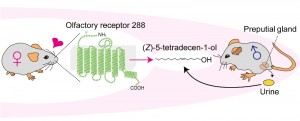An unsaturated aliphatic alcohol in male mouse urine attracts females Discovery of a natural ligand for a mouse odorant receptor


A mouse odorant receptor, Olfr288 (olfactory receptor 288), recognizes male urinary (Z)-5-tetradecen-1-ol as a natural ligand. (Z)-5-tetradecen-1-ol is excreted from the male preputial gland into urine and enhances urine attractiveness to female mice
© Kazushige Touhara
Odorants are detected by odorant receptors in the nose. Little is known about what kind of odorants each odorant receptor recognizes in a natural environment.
In this research, Graduate School of Agricultural and Life Sciences Professor Kazushige Touhara and co-workers have identified (Z)-5-tetradecen-1-ol (Z5-14:OH) as a natural ligand for a mouse odorant receptor. Z5-14:OH is excreted from the preputial gland of male mice into their urine and enhances urine attractiveness to female mice. Z5-14:OH is a novel compound in mammalian species and appears to be a fatty acid metabolite.
Given the fact that the human body odor is also composed by fatty acid metabolites, it will be interesting to examine whether Z5-14:OH or a similar compound plays a role in chemical communication between humans.
Press release (Japanese)
Paper
Keiichi Yoshikawa, Hiroaki Nakagawa, Naoki Mori, Hidenori Watanabe and Kazushige Touhara,
“An unsaturated aliphatic alcohol as a natural ligand for a mouse odorant receptor”,
Nature Chemical Biology, Online Edition: 2013/1/14 (Japan time), doi: 10.1038/nchembio.1164
Article link






